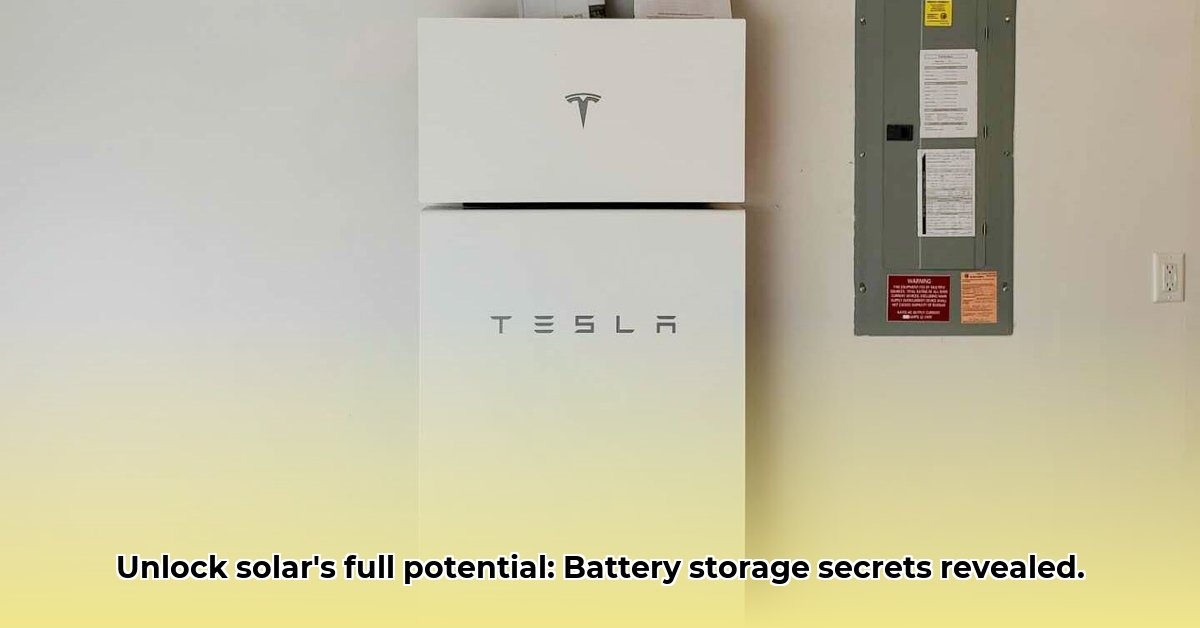Want to truly harness the power of the sun? Storing solar energy is essential! This guide provides a comprehensive overview of home solar battery systems, examining different battery types and helping you select the best option for your needs. We’ll explore the importance of solar energy storage, highlighting the innovators in battery technology and future planning considerations. Whether you’re a homeowner, a business owner, or simply curious, this guide equips you with the knowledge to make informed decisions about solar energy storage and improving energy efficiency. For more on solar energy storage solutions, check out this helpful guide.
Unlocking Solar Potential: Why Battery Storage Matters
Going solar is a great first step toward energy independence and reducing our carbon footprint, but solar power isn’t always available. What happens when the sun isn’t shining? That’s where energy storage comes in. This guide breaks down how to keep your solar power flowing, even during cloudy days or nighttime hours by pairing with energy-efficient appliances. What would energy independence mean for your family?
The Importance of Solar Energy Storage
Solar power is a fantastic and renewable energy source, but its intermittent nature is undeniable. The sun isn’t a 24/7 resource. Storing energy ensures you have power whenever you need it, regardless of weather conditions. Imagine it as your reliable backup power supply, guaranteeing a consistent energy flow to your home. This is particularly crucial during power outages, providing peace of mind and energy independence, offering resilience against grid instability. Battery storage allows you to capture excess energy produced during sunny days and use it when the sun isn’t shining, reducing reliance on the grid.
Popular Methods for Storing Solar Energy
Various options exist for storing solar energy, each with unique advantages and disadvantages:
- Lithium-ion Batteries: The most popular choice today for homes and small businesses due to their relative affordability, high efficiency, and long lifespan. They have a higher energy density, meaning they can store more energy in a smaller space.
- Flow Batteries: Known for their longevity and ability to store massive amounts of energy, ideal for large-scale projects like powering entire neighborhoods or industrial complexes.
- Pumped Hydro Storage: A more established technology that utilizes excess energy to pump water uphill to a reservoir and releases it to generate electricity when needed.
- Thermal Storage: Stores heat by heating materials like water or molten salt using extra solar energy, releasing that heat to generate electricity later. This heated medium is stored in an insulated tank until the energy is needed.
- Compressed Air Energy Storage (CAES): Compresses and stores excess electricity as pressurized air underground in large vessels such as tanks or underground formations, releasing it to spin turbines and generate electricity when needed.
Solar Panel System Comparison Chart: Choosing Your Storage Path
| Technology | Advantages | Disadvantages | Best Use Cases |
|---|---|---|---|
| Lithium-ion Batteries | Efficient, relatively inexpensive, long lifespan, high energy density. | Safety concerns, environmental impact during production and disposal, requires thermal management. | Homes, small businesses, electric vehicles with battery technology. |
| Flow Batteries | Long life, high storage capacity, scalable, non-flammable. | High initial cost, lower energy density compared to lithium-ion, complexity in design. | Large-scale projects, industrial applications, grid stabilization. |
| Pumped Hydro Storage | Environmentally friendly, large capacity, long lifespan, mature technology. | Needs specific geographical conditions (elevation differences), significant environmental impact (land use and alteration of water flow), high upfront costs. | Utility-scale projects, long-duration energy storage. |
| Thermal Storage | Cost-effective (large-scale), sustainable, utilizes readily available materials. | Efficiency depends strongly on temperature, high heat loss, limited applications (primarily for heating and cooling). | Utility-scale projects, district heating and cooling. |
| CAES | Robust, large-scale capacity, long lifespan. | Relatively low efficiency, requires specific geological formations (underground caverns), potential for air leakage. | Large-scale projects, peaking power plants. |
Selecting the Optimal Home Solar Battery System
Choosing the right solar battery system requires careful evaluation:
- Your Energy Needs: Daily power consumption determines the necessary battery system size. What appliances consume the most energy in your household? Consider how often you plan to use stored energy.
- Your Budget: Solar battery systems vary significantly in price. What are the potential options for maintenance and replacements? Lead-acid batteries are generally cheaper, but lithium-ion batteries offer better value in terms of cost, performance, lifespan, and availability.
- Available Space: Battery systems have different space requirements. Space must be carefully considered relative to your existing property. Lithium-ion batteries are typically more compact, making them ideal for smaller homes.
- Local Regulations: Check local authorities for building codes and permits, as specific requirements for installing energy storage systems may exist.
The Importance of Professional Solar Battery Installation
For safety and warranty reasons, professional installation of storage systems is vital. Unless highly experienced with electrical systems, avoid DIY. It’s vital to hire a reputable installer familiar with the specific system and local regulations.
Maintaining Solar Energy Storage
Regular maintenance is key to maximizing the lifespan and efficiency of your energy storage. Always adhere to manufacturer instructions for cleaning and upkeep. This can expand the life of your system and ensure smooth operation for years.
The Future Landscape of Solar Energy Storage
Ongoing research promises advancements in home energy storage that can drastically change the landscape. Consider solid-state batteries offering higher efficiency and improved safety over current lithium-ion technology. The field is rapidly evolving, and improvements and new options are expected to emerge as technology advances, yielding more affordable and effective storage solutions.
Deciphering Lifecycle Costs of Different Solar Battery Technologies for Large-Scale Applications
Key Takeaways:
- Lithium-ion batteries currently dominate the market share, but their costs vary greatly.
- Long-duration energy storage (10+ hours) is a crucial area for future development.
- Comparing lifecycle costs of different solar battery technologies for large-scale projects is important for viability
- Recycling and decommissioning costs are now major factors when looking at the overall impact.
- Geographic limitations affect the applicability of certain technologies based on environmental factors.
- Technological advancements also often create uncertainty in long-term cost predictions and can change the game.
A Dynamic Energy Storage Market
The energy storage market is experiencing rapid growth, with diverse technologies offering solutions, each with distinct cost structures and performance characteristics. While lithium-ion currently leads, pumped hydro, compressed air, and emerging options like zinc and thermal storage are gaining momentum. Cost remains a primary driver of innovation, especially for long-duration storage solutions, and can often change from year to year.
Comprehensive Lifecycle Cost Analysis
When comparing lifecycle costs of different solar battery technologies for large-scale projects, it’s important to look at all factors. Levelized Cost of Storage (LCOS) and Lifecycle Cost (LCC) are key metrics. However, differing methodologies can lead to varied cost predictions that may be difficult to measure. Initial capital expenditure (CAPEX) is significant, but ongoing operational expenses (OPEX), including maintenance and potential replacements, accumulate over time. Don’t forget disposal and recycling costs, which are increasingly considered in LCC calculations. Understanding battery capacity is vital, and it’s measured in kilowatt-hours (kWh).
Technology Comparison: A Detailed Dive
Let’s examine prominent technologies:
- Lithium-ion Batteries: The most prevalent, with different chemistries influencing cost and performance that must be carefully considered. Their relatively shorter lifespan necessitates replacements, impacting the LCC.
- Pumped Hydro Storage: This mature technology is cost-effective for long durations but location-specific, requiring suitable geography. Ideal sites often include mountainous regions where water can easily flow downhill.
- Compressed Air Energy Storage (CAES): Like pumped hydro, CAES faces geographic limitations and also requires suitable geological formations. Air caverns are often salt formations or abandoned mines.
- Emerging Technologies: Zinc and thermal storage are promising but still under development and lack widespread deployment to be cost-effective.
Navigating Regulatory Frameworks
Regulatory policies significantly impact the viability of different energy storage solutions. Incentives, grid interconnection standards, and permitting processes vary considerably and must be considered when choosing for large-scale projects.
Practical Steps for Technology Selection
- Define your needs: What duration of storage is required? What is the scale of your project?
- Conduct a thorough cost analysis: Factor in CAPEX, OPEX, and lifecycle costs for each potential storage option. Use reputable sources for cost estimations.
- Assess risks: Consider technological maturity, supply chain vulnerabilities, environmental impact, and regulatory hurdles.
- Evaluate potential locations: Consider geographical constraints, particularly for pumped hydro and CAES.
- Develop a comprehensive plan: This should include implementation, operation, maintenance, and eventual decommissioning that provides long-term stability.
Real-World Example
In California, Pacific Gas and Electric Company (PG&E) has invested heavily in lithium-ion battery storage systems to enhance grid reliability and integrate renewable energy
- Hydro Extrusions USA Leads North American Aluminum Profile Solutions - December 28, 2025
- Hydro North America Leads Aluminum Extrusion Solutions Across Diverse Industries - December 27, 2025
- Hydro Extrusion North America Provides Custom Solutions Across Diverse - December 26, 2025
















